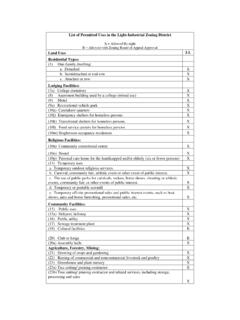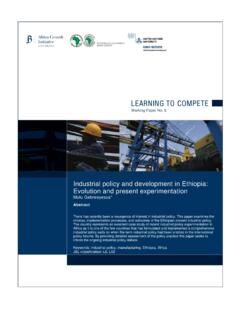Transcription of 11.1 Hot Mix Asphalt Plants - US EPA
1 3/04 Mineral Products Hot Mix Asphalt General1-3,23, 392-394 Hot mix Asphalt (HMA) paving materials are a mixture of size-graded, high quality aggregate(which can include reclaimed Asphalt pavement [RAP]), and liquid Asphalt cement, which is heated andmixed in measured quantities to produce HMA. Aggregate and RAP (if used) constitute over 92 percentby weight of the total mixture. Aside from the amount and grade of Asphalt cement used, mixcharacteristics are determined by the relative amounts and types of aggregate and RAP used. A certainpercentage of fine aggregate (less than 74 micrometers [ m] in physical diameter) is required for theproduction of good quality mix Asphalt paving materials can be manufactured by: (1) batch mix Plants , (2) continuousmix (mix outside dryer drum) Plants , (3) parallel flow drum mix Plants , and (4) counterflow drum mixplants.
2 This order of listing generally reflects the chronological order of development and use within theHMA 1996, approximately 500 million tons of HMA were produced at the 3,600 (estimated) activeasphalt Plants in the United States. Of these 3,600 Plants , approximately 2,300 are batch Plants , 1,000 areparallel flow drum mix Plants , and 300 are counterflow drum mix Plants . The total 1996 HMAproduction from batch and drum mix Plants is estimated at about 240 million tons and 260 million tons,respectively. About 85 percent of Plants being manufactured today are of the counterflow drum mixdesign, while batch Plants and parallel flow drum mix Plants account for 10 percent and 5 percentrespectively. Continuous mix Plants represent a very small fraction of the Plants in use (# percent)and, therefore, are not discussed HMA plant can be constructed as a permanent plant, a skid-mounted (easily relocated) plant,or a portable plant.
3 All Plants can have RAP processing capabilities. Virtually all Plants beingmanufactured today have RAP processing capability. Most Plants have the capability to use eithergaseous fuels (natural gas) or fuel oil. However, based upon Department of Energy and limited Stateinventory information, between 70 and 90 percent of the HMA is produced using natural gas as the fuel todry and heat the Batch Mix Plants ! Figure shows the batch mix HMA production process. Raw aggregate normally isstockpiled near the production unit. The bulk aggregate moisture content typically stabilizes between 3 to5 percent by begins as the aggregate is hauled from the storage piles and is placed in theappropriate hoppers of the cold feed unit. The material is metered from the hoppers onto a conveyer beltand is transported into a rotary dryer (typically gas- or oil-fired).
4 Dryers are equipped with flightsdesigned to shower the aggregate inside the drum to promote drying the hot aggregate leaves the dryer, it drops into a bucket elevator and is transferred to a set ofvibrating screens, where it is classified into as many as four different grades (sizes) and is dropped intoindividual hot bins according to size. At newer facilities, RAP also may be transferred to a separateheated storage bin. To control aggregate size distribution in the final batch mix, the operator opensvarious hot bins over a weigh hopper until the desired mix and weight are obtained. Concurrent with theaggregate being weighed, liquid Asphalt cement is pumped from a heated storage tank to an asphaltbucket, where it is weighed to achieve the desired aggregate-to- Asphalt cement ratio in the final FACTORS3/04 Figure General process flow diagram for batch mix Asphalt Plants (source classification codes in parentheses).
5 33/04 Mineral Products aggregate from the weigh hopper is dropped into the mixer (pug mill) and dry-mixed for6 to 10 seconds. The liquid Asphalt is then dropped into the pug mill where it is mixed for an additionalperiod of time. At older Plants , RAP typically is conveyed directly to the pug mill from storage hoppersand combined with the hot aggregate. Total mixing time usually is less than 60 seconds. Then the hotmix is conveyed to a hot storage silo or is dropped directly into a truck and hauled to the job site. Parallel Flow Drum Mix Plants !Figure shows the parallel flow drum mix process. This process is a continuous mixingtype process, using proportioning cold feed controls for the process materials. The major differencebetween this process and the batch process is that the dryer is used not only to dry the material but also tomix the heated and dried aggregates with the liquid Asphalt cement.
6 Aggregate, which has beenproportioned by size gradations, is introduced to the drum at the burner end. As the drum rotates, theaggregates, as well as the combustion products, move toward the other end of the drum in parallel. Liquid Asphalt cement flow is controlled by a variable flow pump electronically linked to the new (virgin)aggregate and RAP weigh scales. The Asphalt cement is introduced in the mixing zone midway down thedrum in a lower temperature zone, along with any RAP and particulate matter (PM) from mixture is discharged at the end of the drum and is conveyed to either a surge bin or HMAstorage silos, where it is loaded into transport trucks. The exhaust gases also exit the end of the drum andpass on to the collection flow drum mixers have an advantage, in that mixing in the discharge end of the drumcaptures a substantial portion of the aggregate dust, therefore lowering the load on the downstream PMcollection equipment.
7 For this reason, most parallel flow drum mixers are followed only by primarycollection equipment (usually a baghouse or venturi scrubber). However, because the mixing ofaggregate and liquid Asphalt cement occurs in the hot combustion product flow, organic emissions(gaseous and liquid aerosol) may be greater than in other Asphalt mixing processes. Because data are notavailable to distinguish significant emissions differences between the two process designs, this effect onemissions cannot be Counterflow Drum Mix Plants !Figure shows a counterflow drum mix plant. In this type of plant, the material flow in thedrum is opposite or counterflow to the direction of exhaust gases. In addition, the liquid Asphalt cementmixing zone is located behind the burner flame zone so as to remove the materials from direct contactwith hot exhaust Asphalt cement flow is controlled by a variable flow pump which is electronically linkedto the virgin aggregate and RAP weigh scales.
8 It is injected into the mixing zone along with any RAP andparticulate matter from primary and secondary the liquid Asphalt cement, virgin aggregate, and RAP are mixed in a zone removed fromthe exhaust gas stream, counterflow drum mix Plants will likely have organic emissions (gaseous andliquid aerosol) that are lower than parallel flow drum mix Plants . However, the available data areinsufficient to discern any differences in emissions that result from differences in the two processes. Acounterflow drum mix plant can normally process RAP at ratios up to 50 percent with little or noobserved effect upon FACTORS3/04 Figure General process flow diagram for parallel-flow drum mix Asphalt Plants (source classification codes in parentheses).33/04 Mineral Products General process flow diagram for counter-flow drum mix Asphalt Plants (source classification codes in parentheses).
9 FACTORS3 Recycle Processes393 !In recent years, the use of RAP has been initiated in the HMA industry. Reclaimed asphaltpavement significantly reduces the amount of virgin rock and Asphalt cement needed to produce the reclamation process, old Asphalt pavement is removed from the road base. This material isthen transported to the plant, and is crushed and screened to the appropriate size for further paving material is then heated and mixed with new aggregate (if applicable), and the proper amountof new Asphalt cement is added to produce HMA that meets the required quality Emissions And Controls2-3,23 Emissions from HMA Plants may be divided into ducted production emissions, pre-productionfugitive dust emissions, and other production-related fugitive emissions. Pre-production fugitive dustsources associated with HMA Plants include vehicular traffic generating fugitive dust on paved andunpaved roads, aggregate material handling, and other aggregate processing operations.
10 Fugitive dustmay range from m to more than 300 m in aerodynamic diameter. On average, 5 percent of coldaggregate feed is less than 74 m (minus 200 mesh). Fugitive dust that may escape collection beforeprimary control generally consists of PM with 50 to 70 percent of the total mass less than 74 m. Uncontrolled PM emission factors for various types of fugitive sources in HMA Plants are addressed inSections , Crushed Stone Processing , , Paved Roads , , Unpaved Roads , , Heavy Construction Operations , and , Aggregate Handling and Storage Piles. Production-related fugitive emissions and emissions from ducted production operations are discussed below. Emission points discussed below refer to Figure for batch mix Asphalt Plants and to Figures for drum mix Batch Mix Plants !As with most facilities in the mineral products industry, batch mix HMA Plants have two majorcategories of emissions: ducted sources (those vented to the atmosphere through some type of stack, vent,or pipe), and fugitive sources (those not confined to ducts and vents but emitted directly from the sourceto the ambient air).















